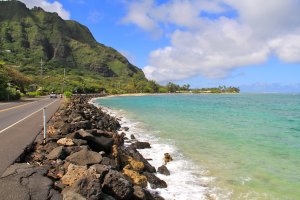
Coastal Access In Hawaii
In recent years, intensifying public controversy in Hawaii has focused on the ongoing loss of beaches and public access statewide. One of the leading concerns is the decreasing number of public access routes to the shoreline as well as lateral access along the shoreline. Historically, lateral shoreline access has been reduced by beach loss, shoreline armoring encroaching vegetation, and other manmade obstructions. Another common problem is a lack of clear information on public access and enforcement responsibilities across the state, which has led to confusion and conflict in some communities over maintaining public access to and along the shoreline.There is currently no comprehensive repository of information on public access available in Hawaii. This website is intended to serve as a community education and outreach effort for improving access to information and laws related to public shoreline access.The University of Hawaii Sea Grant College Program was able to provide this information through a grant from the National Sea Grant Law Center and the Center for Law and Innovation of University of Maine School of Law as a public service in order to improve the management and maintenance of public shoreline access in Hawaii. A public shoreline access website for Maine was developed by these partners and served as this website’s prototype.
Beaches in Hawaii are generally publicly accessible- REGARDLESS OF OWNERSHIP. As part of the public trust doctrine, they are essential public coastal recreational resources. Providing coastal recreational opportunities accessible to the public is a fundamental objective set forth in Chapter 205A, Hawaii Revised Statutes (HRS). Periodical measurement of beach access is required by National Oceanic and Atmospheric Administration’s (NOAA) Office of Ocean and Coastal Resource Management (OCRM) in accordance with the Coastal Zone Management Act (CZMA) for the state CZM program performance.
Public access to the shorelines has become an increasingly controversial issue in Hawaii. Denying public access may be legal if it is occurring on private lands without a specific and dedicated public access easement. Though the laws related to public right of access are clear, not all access is public. Some shoreline accesses retain legal right of privacy, usually due to their creation before the CZMA public access laws. At the time, the property owners were not required by the law to provide public access to the beach as part of the development. In these areas where paths to the beach extend over private lands, property owners are not always required to allow public access. In various places around the state, private roadway access to shoreline areas may be denied to the public for privacy and safety reasons. Some of these closures are permanent while others are in effect during specific hours. Maintenance and liability have been longstanding concerns for private property owners providing public beach access across their property. Escalating concerns regarding vandalism and drug use along public beach accesses within private property are prompting property owners to seek privacy measures.
Disclaimer
With support from the National Sea Grant Law Center, partners from Maine Sea Grant, Maine Coastal Program, The Center for Law and Innovation of University of Maine School of Law, and Island Institute developed the prototype for the derivate site you are now viewing. The prototype has been translated by the University of Hawaiʻi Sea Grant College Program to provide content relevant to audiences in Hawaiʻi. Maine Sea Grant owns the copyright to the prototype site; the adaptations / derivations made here are owned by the University of Hawaiʻi Sea Grant College Program. Neither Maine Sea Grant nor its collaborators are responsible for the content of this derivative Site, including the accuracy of any of the legal information contained in this derivative Site.

